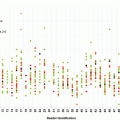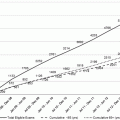Detachable snares reduce immediate and delayed bleeding from pedunculated polyps
Epinephrine injection reduces immediate bleeding from pedunculated and sessile polyps
Cold snaring effective and more efficient than hot snaring for small polyps
Hydroxyethyl starch more effective and efficient submucosal injection fluid than saline
D50 associated with increased risk of post-polypectomy syndrome
Cold snaring more efficient and effective than cold forceps for diminutive polyps
Jumbo forceps more effective and efficient than standard forceps for tiny polyps
Table 13.2
Unanswered questions about colonoscopic polypectomy technique: potential targets for controlled investigation. (Modified from Ref. [52]. With permission from Elsevier)
What is the best methodology for testing completeness of polypectomy at the time of resection? |
Are the long-term outcomes of ESD and EMR different? |
Which electrocoagulation current (e.g., coagulation, blended, microprocessor controlled alternating coagulation/cutting current) is best with regard to safety and effectiveness? |
Can clip closure of large EMR defects reduce the risk of delayed complications? |
Can cold snaring be effectively applied in piecemeal fashion to any set of polyps? |
At what polyp size/shape/histology is electrocautery needed to optimize polypectomy outcomes? |
What are the best methods for defining the edges of serrated lesions prior to polypectomy? What are the best techniques for effective resection of serrated lesions? What is the optimal margin of normal tissue to ensure eradication of serrated lesions? |
What is the value of ancillary imaging techniques (e.g., dye spraying, magnification, electronic chromoendoscopy)? |
Can technical measures such as specialty snares or cap-fitted colonoscopy reduce or eliminate the need for ablative techniques? |
Is it still helpful to systematically apply argon plasma coagulation to EMR defects with clear margins as assessed with high definition and ancillary imaging? |
Conclusion
The effort to understand and improve quality in colonoscopy is still in its infancy. High-quality evidence to support many routine and investigational practices during colonoscopy and polypectomy is lacking. Many colonoscopy and polypectomy practices were established through anecdotal experience and expert consensus, and warrant controlled investigation. Quality targets must be refined and modified to link them to optimal outcomes. There are many opportunities available to clinical investigators interested in improving and refining quality processes in colonoscopy.
References
1.
Rex DK, Cutler CS, Lemmel GT, et al. Colonoscopic miss rates of adenomas determined by back-to-back colonoscopies. Gastroenterol. 1997;112:24–8.CrossRef
2.
3.
4.
5.
6.
7.
8.
9.
Rex DK, Rahmani EY, Haseman JH, et al. Relative sensitivity of colonoscopy and barium enema for detection of colorectal cancer in clinical practice. Gastroenterol. 1997;112:17–23.CrossRef
10.
Baxter N, Sutradhar R, Forbes DD, Paszat LF, Saskin R, Rabeneck L. Analysis of administrative data finds endoscopist quality measures asociated with post-colonoscopy colorectal cancer. Gastroenterol. 2011;140:65–72.CrossRef
11.
12.
13.
Baxter NN, Warren JL, Barrett MJ, et al. Association between colonoscopy and colorectal cancer mortality in a US cohort according to site of cancer and colonoscopist specialty. J Clin Oncol. 2012;30:2664–9.CrossRefPubMedCentralPubMed
Stay updated, free articles. Join our Telegram channel

Full access? Get Clinical Tree





